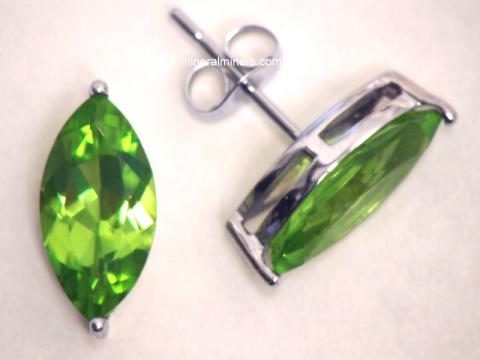


Enter our Virtual Gallery of
MINERALMINERS.COM®- Your Personal 'Link' Direct to the Peridot Mines!TM



Enter our Virtual Gallery of
Peridot Mineral Information Links On This Page:
Return to the Index of Peridot Mineral Information
Peridot is a gem variety of the olivine mineral group. The olivines are isomorphous (all have the same crystal structure), with varying chemical compositions. The most common of the olivines have chemical compositions in the complete solid solution series between pure forsterite (Mg2SiO4) and pure fayalite (Fe2SiO4). A less common solid solution series also exists between the olivine varieties fayalite (Fe2SiO4) and tephroite (Mn2SiO4). Another uncommon solid solution series exists between monticellite (CaMgSiO4) and kirschteinite (CaFeSiO4). The naturally occurring pure calcium chemical end member larnite (Ca2SiO4) does not have the olivine structure.
The green color of peridot, the gem variety of olivine, is mainly dependent on the amount of ferrous iron present, this color then being modified by trace amounts of Fe3+, Ti4+ and Ni2+. The better green colors occur with a Fe:Mg ratio of about 1:8. Higher concentrations of Fe result in less desirable yellow-green or brownish green shades. Pure brown peridots are more rare. Peridot gems have a hardness of about 6.5, which makes them very suitable for use as gemstones in peridot earrings, peridot necklaces, and in most other peridot jewelry except in rings. The use of peridot gems as ringstones and in peridot bracelets requires some extra care to prevent abrasion and loss of polish.


Peridot (olivine) commonly crystalizes very early in the crystallizing sequence of mafic and ultra-mafic igneous rocks at relatively high temperatures. These early formed peridot crystals can settle by gravity forming dunite, a rock composed essentially of olivine, or the rock known as peridotite which also contains pyroxene with occaisional accessories hornblende, ilmenite, garnet, hematite or chromite. Olivine is a common constituent of gabbros and basalts. Still molten underground basalts, in which early formed peridot grains have settled to the bottom by gravity, are occaisionally ejected during volcanic eruptions, and the masses of peridot grains are thrown out as volcanic bombs. Peridot is also found as glassy grains in stony meteorites. Mg-rich olivines form by thermal metamorphism of dolomitic limestones. Fe-rich olivines are less common, occurring in alkali rocks. Fayalite (Fe2SiO4) has been found in gas cavities in volcanic rocks and glasses.
Peridot is usually distinguished by its color, luster and conchoidal fracture. The refractive index and specific gravity of peridot are higher than in tourmaline, and lower than in chrysoberyl, zircon and garnet. Sinhalite has a higher specific gravity and more pronounced pleochrism. Glass and moldavite are isotropic.
The name olivine is from the latin oliva in reference to the mineral's color. Peridot is from a thirteenth century English word peridote.
From ancient times until the eighteenth century, peridot was referred to as 'topazion' or 'topaz', most likely because it was found on the island of Topazios (known today as Zebirget or Isle of St. John in Egypt) in the Red Sea. In the eighteenth century the name topaz was given to our mineral topaz of today, and gem olivine became known as peridot. Yellowish peridot also has been commonly referred to as chrysolite which is from Greek meaning yellow stone. The term chrysolite has also been commonly used in refering to greenish-yellow gem chrysoberyl.
Peridot is used as a gemstone. Mg-rich olivine is used in refractory sand and brick in the casting industry because of its high melting point.
Peridot earrings and other peridot jewelry items are the traditional birthstone gifts for birthdays in the month of August.
The astrological signs of peridot are Virgo, Leo, Libra, Scorpio and Sagittarius.
Peridot is said to bring healing and vitality to the whole body. It is also said to increase patience, confidence and assertiveness.
Peridot is said to help slow the aging process, and to aid in the treatment of digestive, heart, lung and eye disorders. It is also said to be helpfull in facilitating the birthing process.
For more in-depth metaphysical information, see our Metaphysical Books section.
Follow any link below to see more peridot photos.
Return to the Index of Peridot Mineral Information